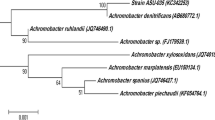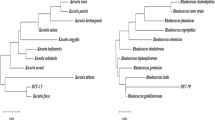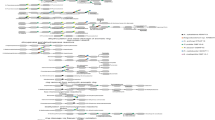Abstract
Strain DN002 isolated from petroleum-contaminated soil was identified as Achromobacter xylosoxidans based on morphological and biochemical properties and 16S rRNA phylogeny, and investigated for its potential to utilize numerous polycyclic aromatic hydrocarbons (PAHs) such as fluoranthene and pyrene as sole carbon and energy resource. Biodegradation studies showed that 500 mg.l−1fluranthene was degraded to 35.6 ± 0.3 mg.l−1 by DN002 after 14 days incubation. During fluoranthene biodegradation, catechol 2,3 dioxygenase (C23O) activity was augmented 1.5 times more than catechol 1,2 dioxygenase (C12O), which indicated that C23O played a major role in fluoranthene degradation by DN002. Protein profiles were examined by sodium dodecyl sulfate polyacrylamide gel electrophoresis and two-dimensional electrophoresis then analyzed by mass spectrometry induced by fluoranthene; a molecular mass range of 18 ∼ 66 kDa proteins were found upregulated compared with the uninduced control sample, including multiple isoenzymes of β-oxidation and dehydrogenases as well as dioxygenases. Besides, some new proteins, i.e., dihydrolipoamide succinyltransferase and aldehyde dehydrogenase family proteins and isocitrate lyase were also synthesized.




Similar content being viewed by others
References
Wilcke, W. (2007). Global patterns of polycyclic aromatic hydrocarbons (PAHs) in soil. Geoderma, 141, 157–166.
Haritash, A. K., & Kaushik, C. P. (2009). Biodegradation aspects of polycyclic aromatic hydrocarbons (PAHs): a review. Journal of Hazardous Materials, 169, 1–15.
Liu, S. C., Wang, C. H., Zhang, S. J., Liang, J., Chen, F., & Zhao, K. (2012). Formation and distribution of polycyclic aromatic hydrocarbons derived from coal seam combustion: a case study of the Ulanqab lignite from Inner Mongolia, Northern China. International Journal of Coal Geology, 90–91, 126–134.
Samanta, S. K., Singh, O. V., & Jain, R. K. (2002). Polycyclic aromatic hydrocarbons: environmental pollution and bioremediation. Trends in Biotechnology, 20, 243–248.
Johnsen, A. R., Wick, L. Y., & Harms, H. (2005). Principles of microbial PAH-degradation in soil. Environmental Pollution, 133, 71–84.
Yan, J., Wang, L., Fu, P. P., & Yu, H. (2004). Photomutagenicity of 16 polycyclic aromatic hydrocarbons from the US EPA priority pollutant list. Mutation Research, 557, 99–108.
Igwo-Ezikpe, M. N., Gbenle, O. G., Ilori, M. O., Okpuzor, J., & Osuntoki, A. A. (2010). High molecular weight polycyclic aromatic hydrocarbons biodegradation by bacteria isolated from contaminated soils in Nigeria. Research Journal of Environmental Sciences, 4, 127–137.
Kanaly, R. A., & Harayama, S. (2000). Biodegradation of high-molecular-weight polycyclic aromatic hydrocarbons by bacteria. Journal of Bacteriology, 182, 2059–2067.
Klankeo, P., Nopcharoenkul, W., & Pinyakong, O. (2009). Two novel pyrene-degrading Diaphorobacter sp. and Pseudoxanthomonas sp. isolated from soil. Journal of Bioscience and Bioengineering, 108, 488–495.
Kanaly, R. A., & Harayama, S. (2010). Advances in the field of high-molecular-weight polycyclic aromatic hydrocarbon biodegradation by bacteria. Microbial Biotechnology, 3, 136–164.
Kweon, O., Kim, S. J., Jones, R. C., Freeman, J. P., Adjei, M. D., Edmondson, R. D., & Cerniglia, C. E. (2007). A polyomic approach to elucidate the fluoranthene degradative pathway in Mycobacterium vanbaalenii PYR-1. Journal of Bacteriology, 189, 4635–4647.
Chen, S. H., & Aitken, M. D. (1999). Salicylate stimulated the degradation of high molecular weight polycyclic aromatic hydrocarbons by Pseudomonas sacchrophia P15. Environmental Science and Technology, 33, 435–439.
Lee, Y. K., Kwon, K. K., Cho, K. H., Park, J. H., & Lee, H. K. (2003). Culture and identification of bacteria from marine biofilms. The Journal of Microbiology, 41, 183–188.
Thompson, J. D., Gibson, T. J., Plewniak, F., Jeanmougin, F., & Higgins, D. G. (1994). The Clustal X windows interface: flexible strategies for multiple sequence alignment aided by quality analysis tools. Nucleic Acids Research, 24, 4876–4882.
Tamura, K., Dudley, J., Nei, M., & Kumar, S. (2007). MEGA4: molecular evolutionary genetics analysis (MEGA) software version 4.0. Molecular Biology and Evolution, 24, 1596–1599.
Kumar, S., Nei, M., Dudley, J., & Tamura, K. (2008). MEGA: a biologist-centric software for evolutionary analysis of DNA and protein sequences. Briefings in Bioinformatics, 9, 299–306.
Das, K., & Mukherjee, A. K. (2007). Crude petroleum oil biodegradation efficiency of Bacillus subtilis and Pseudomonas aeruginosa strains isolated from a petroleum-oil contaminated soil from north-east India. Bioresource Technology, 98, 1339–1345.
Kojima, Y., Itada, N., & Hayaishi, O. (1961). Metapyrocatachase: a new catechol-cleaving enzyme. The Journal of Biological Chemistry, 236, 2223–2228.
Lehesranta, S. J., Davies, H. V., Shepherd, L. V. T., Nunan, N., McNicol, J. W., Auriola, S., Koistinen, K. M., Suomalainen, S., Kokko, H. I., & Karenlampi, S. O. (2005). Comparison of tuber proteomes of potato varieties, landraces and genetically modified lines. Plant Physiology, 38, 1690–1699.
Neuhoff, V., Arold, N., Taube, D., & Ehrhardt, W. (1988). Improved staining of proteins in polyacrylamide gels including isoelectric focusing gels with clear background at nanogram sensitivity using Coomassie brilliant blue G-250 and R-250. Electrophoresis, 9, 255–262.
Shevchenko, A., Tomas, H., Havlis, J., Olsen, J. V., & Mann, M. (2006). In-gel digestion for mass spectrometric characterization of proteins and proteomes. Nature Protocols, 1, 2856–2860.
Smith, M. R. (1994). The physiology of aromatic hydrocarbon degrading bacteria. In C. Ratledge (Ed.), Biochemistry of Microbial Degradation (pp. 347–378). Dordrecht: Kluwer Academic Publishers.
Lin, Y., & Cai, L. X. (2008). PAH-degrading microbial consortium and its pyrene-degrading plasmids from mangrove sediment samples in Huian, China. Marine Pollution Bulletin, 57, 703–706.
Kim, Y. H., Engesser, K. H., & Cerniglia, C. E. (2005). Numerical and genetic analysis of polycyclic aromatic hydrocarbon degrading Mycobacteria. Microbial Ecology, 50, 110–119.
Kweon, O., Kim, S. J., Holland, R. D., Chen, Y., Kim, D. W., Gao, Y., Yu, L. R., Baek, S., Ahn, H., & Cerniglia, C. E. (2011). Polycyclic aromatic hydrocarbon metabolic network in Mycobacterium vanbaalenii PYR-1. Journal of Bacteriology, 193, 4326–4337.
Cenci, G., & Caldini, G. (1997). Catechol dioxygenase expression in a Pseudomonas fluorescens strains exposed to different aromatic compounds. Applied Microbiology and Biotechnology, 47, 306–308.
Dhote, M., Juwarkar, A., Kumar, A., Kanade, G. S., & Chakrabarti, T. (2010). Biodegradation of chrysene by the bacterial strains isolated from oily sludge. World Journal of Microbiology and Biotechnology, 26, 329–335.
Kumar, S., Upadlhayay, S. K., Kumari, B., Tiwari, S., Singh, S. N., & Singh, P. K. (2011). In vitro degradation of fluoranthene by bacteria isolated from petroleum sludge. Bioresource Technology, 102, 3709–3715.
Kim, S. J., Jones, R. C., Cha, C. J., Kweon, O., Edmondson, R. D., & Cerniglia, C. E. (2004). Identification of proteins induced by polycyclic aromatic hydrocarbon in Mycobacterium vanbaalenii PYR-1 using two-dimensional polyacylamide gel electrophoresis and de novo sequencing methods. Proteomics, 4, 3899–3908.
Stingley, R. L., Brezna, B., Khan, A. A., & Cerniglia, C. E. (2004). Novel organization of genes in a phthalate degradation operon of Mycobacterium vanbaalenii PYR-1. Microbiology, 150, 3749–3761.
Acknowledgments
We thank our lab members for critical review of the manuscript. This work was supported by a project supported by the National Science Foundation for Young Scientists of China (Grant No. 31000069) and the project of Key Laboratory of Resources Biology and Biotechnology in Western China, Ministry of Education (ZS12007).
Author information
Authors and Affiliations
Corresponding author
Rights and permissions
About this article
Cite this article
Ma, YL., Lu, W., Wan, LL. et al. Elucidation of Fluoranthene Degradative Characteristics in a Newly Isolated Achromobacter xylosoxidans DN002. Appl Biochem Biotechnol 175, 1294–1305 (2015). https://doi.org/10.1007/s12010-014-1347-7
Received:
Accepted:
Published:
Issue Date:
DOI: https://doi.org/10.1007/s12010-014-1347-7




